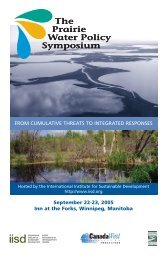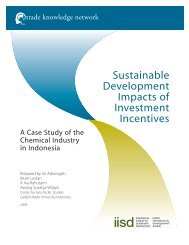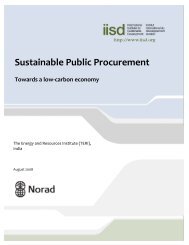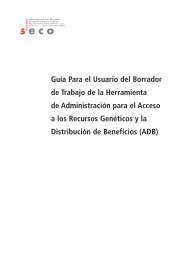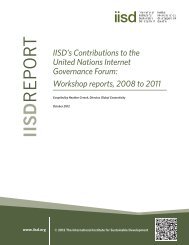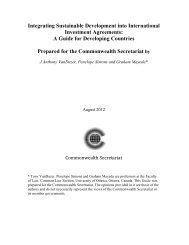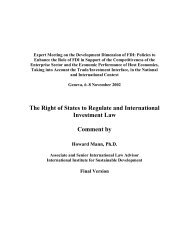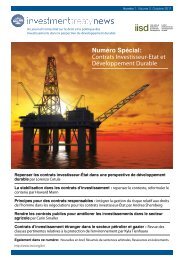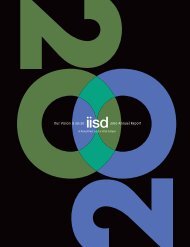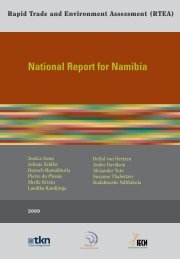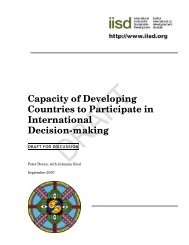Ecosystem Approaches in IWRM - International Institute for ...
Ecosystem Approaches in IWRM - International Institute for ...
Ecosystem Approaches in IWRM - International Institute for ...
Create successful ePaper yourself
Turn your PDF publications into a flip-book with our unique Google optimized e-Paper software.
Transboundary river bas<strong>in</strong> case studies<br />
Water-Energy-Food Security
Presentation Outl<strong>in</strong>e<br />
• Importance of transboundary bas<strong>in</strong>s<br />
• <strong>IWRM</strong>—Integration<br />
• State of <strong>IWRM</strong> implementation study<br />
• Case studies—ES offers a “benefits shar<strong>in</strong>g”<br />
approach<br />
• Lessons and Framework<br />
• Evolution of <strong>IWRM</strong> <strong>for</strong> W-E-F <strong>in</strong>tegration
Transboundary Watersheds<br />
Source: Revenga et. al. 2003. IUCN, IWMI, Ramsar Convention Bureau and<br />
WRI.
Integrated Water Resources Management<br />
• <strong>IWRM</strong>—Coord<strong>in</strong>ated management of water, land and<br />
related resources to equitably maximize the result<strong>in</strong>g<br />
economic and social welfare without compromis<strong>in</strong>g<br />
the susta<strong>in</strong>ability of vital ecosystems.<br />
• Ma<strong>in</strong> Hypotheses:<br />
• <strong>IWRM</strong> is the practical means <strong>for</strong> advanc<strong>in</strong>g large-scale ecosystem<br />
management.<br />
• However, <strong>in</strong>stitutional capacity and <strong>in</strong>struments <strong>for</strong> <strong>IWRM</strong> are weakly<br />
developed and are complex at the transboundary level.<br />
• Communicat<strong>in</strong>g ecosystem service benefits and harness<strong>in</strong>g ecosystem<br />
markets are promis<strong>in</strong>g ways to strengthen <strong>IWRM</strong>.
Integrated Water Resources Management<br />
Pr<strong>in</strong>ciples<br />
Economic<br />
Per<strong>for</strong>mance<br />
Social<br />
Per<strong>for</strong>mance-<br />
Equity<br />
Environmental<br />
Per<strong>for</strong>mance-<br />
Susta<strong>in</strong>ability<br />
Structure<br />
Management<br />
Instruments<br />
• Assessment<br />
• In<strong>for</strong>mation<br />
• Allocation<br />
Enabl<strong>in</strong>g<br />
Instruments<br />
• Policy<br />
• Legislation<br />
• Economic<br />
Incentives<br />
Institutional<br />
Framework<br />
• Scale<br />
• River Bas<strong>in</strong><br />
Organization<br />
• Partnerships<br />
and resources<br />
Water <strong>for</strong> livelihood, water as resource, Water as ecosystem<br />
good<br />
Source: Adapted from Global Water Partnership <strong>IWRM</strong> Framework
<strong>IWRM</strong> Commitments and Adoption<br />
Source: UN-Water
Transboundary Case Studies<br />
• Red River Bas<strong>in</strong> (North America)<br />
• Jordan River Bas<strong>in</strong> (West Asia)<br />
• Mekong River Bas<strong>in</strong> (Asia Pacific)<br />
• Danube River Bas<strong>in</strong> (Europe)<br />
• La Plata River Bas<strong>in</strong> (Lat<strong>in</strong><br />
America and the Caribbean)<br />
• Okavango River Bas<strong>in</strong> (Africa)<br />
• Congo River Bas<strong>in</strong> (Africa)
Red River Bas<strong>in</strong> Case Study<br />
• Bas<strong>in</strong> area: 116,550 km 2<br />
• Bas<strong>in</strong> countries: Canada,<br />
United States<br />
• Primary issues <strong>for</strong><br />
management: Floods,<br />
droughts, nutrient<br />
management<br />
Source: Sch<strong>in</strong>delka, R. 1999.<br />
http://www.rrbd<strong>in</strong>.org/data/redriverbas<strong>in</strong>.pdf
Lake<br />
W<strong>in</strong>nipeg<br />
W<strong>in</strong>nipeg<br />
Saskatchewan<br />
Manitoba<br />
Red River and<br />
Bas<strong>in</strong>
Red River Sub-Bas<strong>in</strong> <strong>Ecosystem</strong> Service<br />
Analysis—chang<strong>in</strong>g the discourse<br />
• Pre-settlement to<br />
present comparative<br />
analysis<br />
• Value of ES lost:<br />
CAD$0.2b–<br />
CAD$2.05b/annually<br />
• ~80% climate and<br />
water regulation<br />
• Policy Shift to<br />
Susta<strong>in</strong>able<br />
Agriculture and<br />
Wetlands<br />
Protection
Red River Sub-Bas<strong>in</strong> <strong>Ecosystem</strong> Service<br />
Analysis—chang<strong>in</strong>g the discourse<br />
• Pre-settlement to<br />
present comparative<br />
analysis<br />
• Value of ES lost:<br />
CAD$0.2b–<br />
CAD$2.05b/annually<br />
• ~80% climate and<br />
water regulation<br />
• Policy Shift to<br />
Susta<strong>in</strong>able<br />
Agriculture and<br />
Wetlands<br />
Protection
Jordan River Bas<strong>in</strong><br />
• Bas<strong>in</strong> area: 18,000 km 2<br />
• Bas<strong>in</strong> countries: Syria, Israel,<br />
Jordan, Palest<strong>in</strong>e and Lebanon<br />
• Primary management issues: Water<br />
quantity, water quality and<br />
equitable shar<strong>in</strong>g of the resource<br />
Source: UNEP/DEWA/GRID~Europe
Jordan River Bas<strong>in</strong><br />
• Long history of political and waterbased<br />
conflict<br />
• No <strong>in</strong>stitutional mechanism <strong>for</strong> bas<strong>in</strong>wide<br />
management<br />
• <strong>IWRM</strong> strengthen<strong>in</strong>g led by Scientific<br />
and NGO communities—notably:<br />
• GLOWA project emphasiz<strong>in</strong>g mgmt<br />
tools, and<br />
• FoEME conservation and trustbuild<strong>in</strong>g<br />
projects among municipal<br />
leaders<br />
• Recommendations <strong>for</strong> <strong>in</strong>corporation of<br />
ecosystem services approach (Al-<br />
Jayyousi and Bergkamp, 2008)<br />
Photographer: Bryan Oborne
Mekong River Bas<strong>in</strong> Case Study<br />
• Bas<strong>in</strong> area: 795,000 km 2<br />
• Bas<strong>in</strong> countries: Ch<strong>in</strong>a,<br />
Myanmar, Lao PDR,<br />
Cambodia, Thailand and<br />
Vietnam<br />
• Primary management<br />
issues: Flood management,<br />
fisheries, agriculture,<br />
navigation, hydropower and<br />
environment<br />
Source: Revenga, et al. 1998, 2-92
Mekong River Bas<strong>in</strong> Case Study:<br />
Key <strong>IWRM</strong> Agency: Mekong River Commission<br />
• Fragmented bas<strong>in</strong> management amongst MRC<br />
and upper riparians—although probably not the<br />
critical management issue<br />
• Economic goals—largely hydropower<br />
development vs. wetland and biodiversity<br />
protection.<br />
• MRC has an <strong>IWRM</strong> agenda, while other<br />
agencies—ASEAN, GMS Economic Cooperation<br />
Program, MWRAS—have hydropower agenda<br />
• <strong>Ecosystem</strong> services framework to potentially<br />
provide common ground <strong>for</strong> bas<strong>in</strong>-wide<br />
management—detailed analysis of the services<br />
associated with the Sonle Tap wetlands of<br />
Cambodia probably most illustrative of synergies<br />
and tradeoffs with other bas<strong>in</strong> development<br />
objectives<br />
Photographer: Dimple Roy
Danube River Bas<strong>in</strong> Case Study<br />
• Bas<strong>in</strong> area: 801,463 km 2<br />
• Bas<strong>in</strong> countries: Austria,<br />
Albania, Bosnia and<br />
Herzegov<strong>in</strong>a, Bulgaria,<br />
Croatia, Czech Republic,<br />
Germany, Hungary, Italy,<br />
Macedonia, Moldova,<br />
Poland, Romania, Serbia<br />
and Montenegro, Slovak<br />
Republic, Slovenia,<br />
Switzerland, and Ukra<strong>in</strong>e<br />
• Primary management<br />
issues: loss of<br />
biodiversity, NPS impacts<br />
from agriculture on water<br />
quality,<br />
Source: Revenga, et al. 1998, 2-38
Danube River Bas<strong>in</strong> Case Study<br />
Key <strong>IWRM</strong> Agency: ICPDR<br />
• WFD provides strong guidance but its<br />
complexity and the EU/non-EU dist<strong>in</strong>ction and<br />
<strong>in</strong>come gradient offer significant challenges to<br />
implementation.<br />
• Loss of ecosystem services <strong>in</strong>clude wetland<br />
losses, <strong>for</strong>est services, decl<strong>in</strong>es <strong>in</strong> water<br />
availability and quality and loss of recreational<br />
and aesthetic value.<br />
• Implementation challenges are magnified by<br />
the lack of agricultural and regional<br />
development representation on ICPDR as<br />
implement<strong>in</strong>g agencies at national level.<br />
• WWF is work<strong>in</strong>g on promot<strong>in</strong>g an ecosystem<br />
services approach <strong>in</strong> the bas<strong>in</strong> from the topdown<br />
(at the EU level) as well as bottom-up<br />
(with regional pilot <strong>in</strong>itiatives).<br />
Photographer: Alec Craw<strong>for</strong>d
La Plata River Bas<strong>in</strong> Case Study<br />
Source: Revenga , et al. 1998, 2-157<br />
• Bas<strong>in</strong> area: 3,100,000 km 2<br />
• Bas<strong>in</strong> countries: Paraguay,<br />
Uruguay, Argent<strong>in</strong>a, Brazil,<br />
Bolivia<br />
• Primary issues <strong>for</strong><br />
management: Water<br />
quality, flood<strong>in</strong>g,<br />
de<strong>for</strong>estation, biodiversity,<br />
<strong>in</strong>vasive species, fish losses,<br />
and climate change, aquifer<br />
depletion and<br />
contam<strong>in</strong>ation
La Plata River Bas<strong>in</strong> Case Study<br />
Key <strong>IWRM</strong> Agency: CIC<br />
• Long history of bilateral and trilateral<br />
agreements among riparians generally <strong>for</strong><br />
hydropower and navigation<br />
• <strong>Ecosystem</strong> services approach as a means of<br />
demonstrat<strong>in</strong>g the impacts of development<br />
schemes on upstream wetlands; Pantanal<br />
Wetland—modulates hydrology; reta<strong>in</strong>s<br />
nutrients, extremely biodiverse and threatened<br />
by the Hydrovia project.<br />
• Yacreta hydro project currently constra<strong>in</strong>ed by<br />
ecosystem impacts<br />
• Successful protection of Guarani aquifer<br />
demonstrates that co-operative management<br />
can protect key ecological assets.<br />
Photographer: Alec Craw<strong>for</strong>d
Okavango River Bas<strong>in</strong> Case Study<br />
• Bas<strong>in</strong> area: 704,000 km 2<br />
• Bas<strong>in</strong> countries: Angola,<br />
Botswana, Namibia and<br />
Zimbabwe<br />
• Primary issues <strong>for</strong><br />
management: Water<br />
quality, Soil erosion, urban<br />
development, tourism,<br />
biodiversity and the<br />
management of the<br />
Okavango Delta.<br />
Source: Revenga, et al. 1998, 2-26
Okavango River Bas<strong>in</strong> Case Study<br />
Source: Cubango-Okavango River Bas<strong>in</strong> Transboundary Diagnostic Analysis, 2011
Source: Cubango-Okavango River Bas<strong>in</strong> Transboundary Diagnostic Analysis, 2011
Congo River Bas<strong>in</strong> Case Study—extremely biodiverse;<br />
Key <strong>IWRM</strong> Agency: CICOS<br />
• Bas<strong>in</strong> area: 3,680,000<br />
km 2<br />
• Bas<strong>in</strong> countries:<br />
Angola, Cameroon, the<br />
Central African<br />
Republic, the Republic<br />
of Congo, and the<br />
Democratic Republic of<br />
Congo<br />
• Primary management<br />
issues: De<strong>for</strong>estation,<br />
navigation, water<br />
pollution, <strong>in</strong>vasive<br />
species and water<br />
transfers<br />
Source: Revenga, et al. 1998, 2-11
Congo River Bas<strong>in</strong> Case Study<br />
• As usual, <strong>in</strong>terest <strong>for</strong> bas<strong>in</strong>-scale <strong>IWRM</strong> comes from<br />
hydro and navigation—both of which are threatened<br />
by de<strong>for</strong>estation/biodiversity loss (loss of the water<br />
towers).<br />
• CICOS strategic action plan <strong>in</strong> development—refers to<br />
l<strong>in</strong>ks with UNDP/GEF Strategic Program <strong>for</strong> SFM <strong>in</strong><br />
Congo Bas<strong>in</strong> and the Congo Bas<strong>in</strong> Forest Partnership.<br />
• L<strong>in</strong>ks to Carbon and Biodiversity Markets obvious but<br />
undeveloped
Case Studies Synthesis<br />
• <strong>IWRM</strong>—while ma<strong>in</strong>streamed as framework, under-resourced and underm<strong>in</strong>ed<br />
<strong>in</strong> implementation.<br />
• Very early days <strong>for</strong> <strong>Ecosystem</strong> Approach-<strong>IWRM</strong><br />
• <strong>Ecosystem</strong> Management and Climate Adaptation issues are assert<strong>in</strong>g<br />
themselves as high priorities <strong>in</strong> all bas<strong>in</strong>s.<br />
• Only La Plata and Okavango had an ES valuation analysis—protection of<br />
Guarani aquifer and the Okavango Delta play important role.<br />
• Jordan—ES deemed essential <strong>for</strong> progress<br />
• Danube—WWF pilot<strong>in</strong>g PES schemes<br />
• Mekong and Congo – ES analysis would help highlight trade-offs and synergies<br />
between ecosystem protection and conventional development.<br />
• Bas<strong>in</strong>-scale <strong>Ecosystem</strong> Service <strong>in</strong>ventory and trend analysis can help bas<strong>in</strong><br />
analysts understand a whole new class of w<strong>in</strong>-w<strong>in</strong> opportunities.<br />
• Next-generation <strong>IWRM</strong> <strong>in</strong>stitutional capacity build<strong>in</strong>g will <strong>in</strong>volve ES analysis<br />
and visualization, ES communication, ES market development.
ES Approach to <strong>IWRM</strong>
BioEconomy as a facilitator of <strong>IWRM</strong><br />
$$ Localized bioenergy production<br />
$$ Habitat and biodiversity<br />
production<br />
$$ Public health benefits of nutrient<br />
and hydrologic management<br />
$$ Recreation<br />
$$ Biomass-based value cha<strong>in</strong>s<br />
$$ Nutrient management and<br />
recycl<strong>in</strong>g <strong>for</strong> fertilizers<br />
$$ Increased food security<br />
$$ Water storage <strong>for</strong> flood and<br />
drought mitigation
Evolution of <strong>IWRM</strong> us<strong>in</strong>g EGS and<br />
Bioeconomy as drivers<br />
Water<br />
Security<br />
Food<br />
Security<br />
Energy<br />
Security<br />
Bioeconomy<br />
benefits and<br />
value cha<strong>in</strong>s<br />
as potential<br />
drivers



